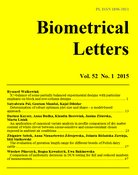
Biometrical Letters Vol. 52(1), 2015, pp. 13-22


|
DETERMINATION OF ROBUST OPTIMUM PLOT SIZE AND SHAPE - A MODEL-BASED APPROACH Satyabrata Pal1,2, Goutam Mandal3, Kajal Dihidar4 1Sampling and Official Statistics Unit, Indian Statistical Institute, Kolkata, 700108, India, 2Dean, Post Graduate Studies and Professor of Statistics, Bidhan Chandra Krishi Viswavidyalaya, W.B., Pin-741252, India, e-mail: satyabrata.pal@hotmail.com 3Guru Nanak Institute of Technology, Sodepur, West Bengal, Pin-700114, India, e-mail: gmandal@gmail.com 4Sampling and Official Statistics Unit, Indian Statistical Institute, Kolkata, 700108, India, e-mail: kajaldihidar@gmail.com |

Determination of optimum plot size has been regarded as an important and useful area of study for agriculturists and statisticians since the first remarkable contribution on this problem came to light in a paper by Smith (1938). As we explore the scientific literature relating to this problem, we may note a number of contributions, including those of Modjeska and Rawlings (1983), Webster and Burgess (1984), Sethi (1985), Zhang et al. (1990, 1994), Bhatti et al.(1991), Fagroud and Meirvenne (2002), etc. In Pal et al. (2007), a general method was presented by means of which the optimum plot size can be determined through a systematic analytical procedure. The importance of the procedure stems from the fact that even with Fisherian blocking, the correlation among the residuals is not eliminated (as such the residuals remain correlated). The method is based on an application of an empirical variogram constructed on real-life data sets (obtained from uniformity trials) wherein the data are serially correlated. This paper presents a deep and extensive investigation (involving theoretical exploration of the effect of different plot sizes and shapes in discovering the point – actually the minimum radius of curvature of the variogram at that point – beyond which the theoretical variogram assumes stationary values with further increase in lags) in the case of the most commonly employed model (incorporating a correlation structure) assumed to represent real-life data situations (uniformity trial or designed experiments, RBD/LSD).

non-random data, model-based theoretical variogram, radius of curvature, robust optimum plot sizes and shapes
